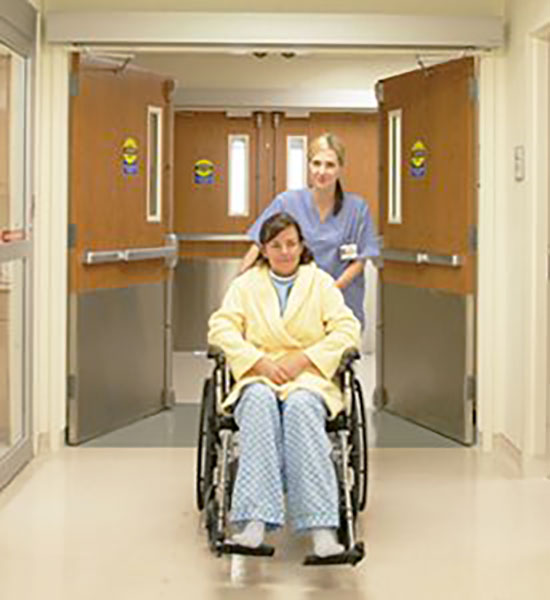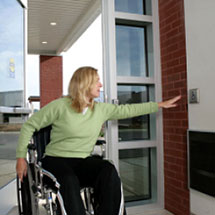How Automatic Door Systems Improve Accessibility and Compliance
July 18, 2025
Automatic door systems are more than a convenience—they are key to ensuring that all individuals can safely and independently access commercial buildings. Whether at a hospital entrance, corporate office, school, or public facility, handicap accessible doors that operate reliably and predictably serve as critical accessibility tools for people with physical or cognitive impairments.

From compliance with national standards to the real-life challenges of daily use, automatic doors are central to both inclusive design and practical building management. In an interview with door industry expert, John Gollihar, Engineering Manager at Horton Automatics and Vice President of the American Association of Automatic Door Manufacturers (AAADM), he emphasized that the greatest challenges to accessibility often arise after installation—not during. Automatic doors, he notes, are essential to both compliance and day-to-day usability.
Understanding ADA and AODA Standards
In the U.S., the Americans with Disabilities Act (ADA) mandates accessibility in commercial spaces, while in Canada, the Accessibility for Ontarians with Disabilities Act (AODA) establishes similar requirements. These acts both reference the International Building Code (IBC) and ANSI standards such as A156.10, which governs power-assisted door systems and automatic door operators.
These standards define essential elements like:
- Minimum door opening widths
- Manual opening forces and door handle access
- Required automation in specific occupancies
- Safety features such as breakaway for egress and safe maneuvering clearance
- Clear approach zones and unobstructed accessible route paths
John notes that technicians and installers must ensure these codes are applied properly in the field—not just on paper.
Real-Life Accessibility Benefits
Automatic doors significantly reduce the physical effort required to enter or exit a building, eliminate the need for grip strength or fine motor control, and improve safety in high-traffic or weather-exposed environments.
For users with wheelchairs, walkers, or visual impairments—and even for parents with strollers or delivery personnel—automatic doors improve navigation, reduce frustration, and support safer movement. In certain cases, manual doors can pose a hazard if they swing forcefully or unexpectedly, especially in windy conditions or crowded public entrances.

Common Pitfalls in Commercial Installations
Even well-intentioned installations can fall short of functional accessibility. Among the most common problems:
Inaccessible Activation Devices
“Push plates or wave sensors are often placed in locations that require users to leave their path of travel or navigate around obstacles. This not only delays access but can create safety concerns if the door opens or closes before the user is fully through,” says John Gollihar, Engineering Manager at Horton Automatics and Vice President of AAADM. Devices placed too far from the door or behind a wall reduce usability—even if technically compliant. This is especially true for handicap door opener systems.
Inadequate Signage
Some property owners minimize signage for aesthetic reasons. However, clear, code-compliant signage is required to inform users of how to activate the door opener, what direction it operates in, and whether there are one-way or restricted paths. These indicators are essential for visitors, especially those with visual impairments or unfamiliar with the building.
Obstructed Maneuvering Space
Accessibility standards require clear floor space around the accessible door so users can approach and exit easily. Bollards, trash bins, or building features that narrow the entry path can turn a compliant automatic door into a non-functional one. John emphasizes the importance of leaving room not just for compliance, but for comfort and safety.
Preventative Maintenance: A Compliance Essential

Most accessibility breakdowns happen not because a door was installed incorrectly—but because it wasn’t maintained properly.
Regular upkeep ensures that all sensors are aligned, speeds are calibrated, and activation methods are functional. Preventative maintenance protects users and minimizes downtime, helping buildings avoid costly repairs, code violations, or liability claims—especially with entry doors and other high-traffic pedestrian access doors.
There are two key levels of inspection:
Daily Safety Checks
Performed by facility staff, these walk-through tests ensure doors are functioning as intended and not showing signs of irregularity. AAADM recommends these be done daily, using simple checklists available in the door’s user manual or on a label adhered to the door.
Annual Certified Inspections
These cover speed, force, signage, sensor range, and more, and are recommended both annually and after any service activity. Technicians should be AAADM-certified and follow standard procedures to verify compliance. John adds, “part of AAADM-certified technician’s role is to explain the inspection to the building owner—what passed, what needs correction, and what’s next.”
Activation Technology: Matching the Method to the Environment
There are two broad types of activation systems used in automatic door applications:
Non-Knowing Act
Includes motion sensors, floor mats, and camera-based systems that trigger automatically as users approach. These systems are the most accessible and require no physical interaction. These reduce barriers and are ideal for general public access, particularly for handicap accessible doors and individuals with mobility limitations.
Knowing Act
Includes push plates, wave sensors, and card readers that require a deliberate action. These are often used in areas where false triggers are a concern, such as hospital corridors or secure entries.
Both systems can meet compliance if installed and maintained properly, but non-knowing systems tend to be more inclusive—particularly for users with mobility aid devices. Dual-technology systems that combine safety and convenience are increasingly common, and prices have come down significantly in recent years.
Technician Training and Response Time
Accessibility isn’t just about the door—it’s about the people who maintain it. Technicians who install or service automatic door systems must be trained in current standards and use proper adjustment methods to ensure that the system functions as designed.
Building staff are the first line of defense—they see the door every day. But once an issue is detected, fast response and correct service are essential. John explains, “The technician’s role is to restore both safety and compliance—not just operation.”
Companies like Door Services Corporation ensure technicians arrive quickly with stocked vans and the certifications needed to complete the job on the first visit. This prevents prolonged outages and avoids rework due to missing parts or inadequate training—common frustrations for building managers who rely on their commercial door to keep people moving.
Staying Current: Technology and Codes Are Always Evolving
Standards like ANSI A156.10 are updated every four years, and building codes such as the IBC and NFPA evolve on a similar cycle. New technology—like touchless “virtual push plates” or advanced camera sensors—is increasingly being adopted into these frameworks.
While changes are incremental, they aim to improve safety and usability. Facility managers and service providers must stay informed to ensure systems—especially existing doors—remain compliant over time. John adds that it's critical to understand how new tools integrate with current safety expectations before installing them.
Beyond Compliance: Building for Inclusion and Safety
Automatic doors are fundamental to accessible entrance design. But compliance isn’t enough. For ADA doors to serve all users effectively, they must be properly configured, clearly marked, and consistently maintained.
With the right service partner and an ongoing commitment to standards, building owners can be confident their commercial doors support equal access for everyone.
John sums it up simply: “Accessibility doesn’t stop at installation. The way doors are used and maintained every day is just as important as how they’re designed.”
Check out John dicussing the importance of powered doors and accessibility here!
Frequently Asked Questions
1. What codes do automatic doors need to comply with in the U.S. and Canada?
In the U.S., automatic doors must comply with the Americans with Disabilities Act (ADA). In Ontario, they fall under the Accessibility for Ontarians with Disabilities Act (AODA). Both reference ANSI A156.10 and the IBC.
2. Why do some automatic doors fail accessibility compliance even if they function?
Failures often arise from poor push plate placement, obstructed maneuvering clearance, insufficient signage, or inadequate maintenance—not necessarily from the automatic door itself.
3. How often should automatic doors be inspected?
Daily visual checks and annual certified inspections (or post-service evaluations) are recommended to ensure safe operation and ADA compliance.
4. What’s the difference between knowing-act and non-knowing-act systems
Knowing-act systems (e.g., push plates) require user interaction. Non-knowing-act systems (e.g., motion sensors) activate automatically—making them more inclusive.
5. How do service technicians impact accessibility compliance?
Technicians ensure the accessible doors function within ADA and AODA standards. Their expertise and fast response help maintain both safety and accessibility over time.
